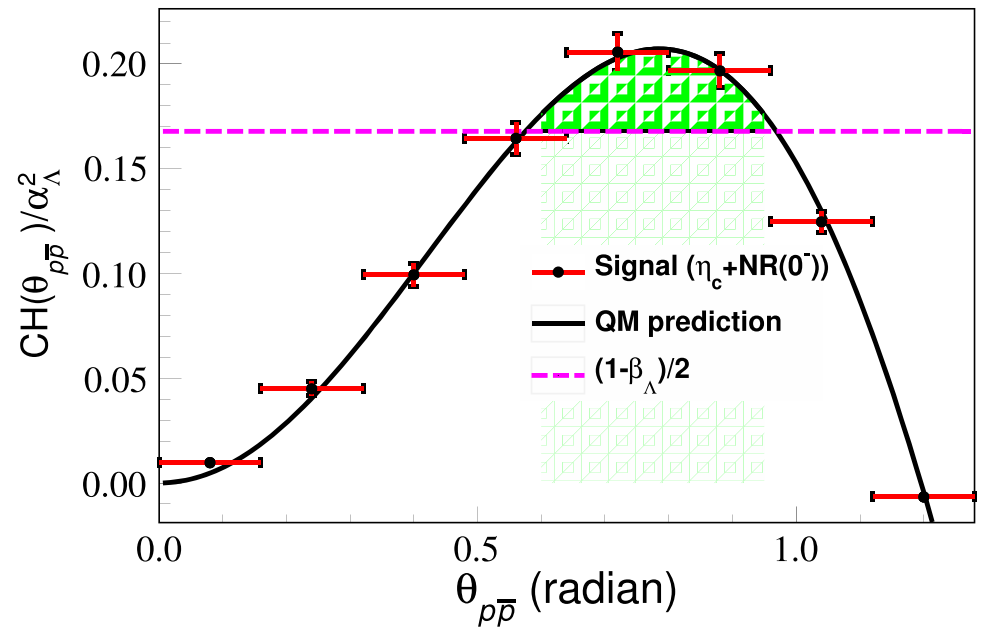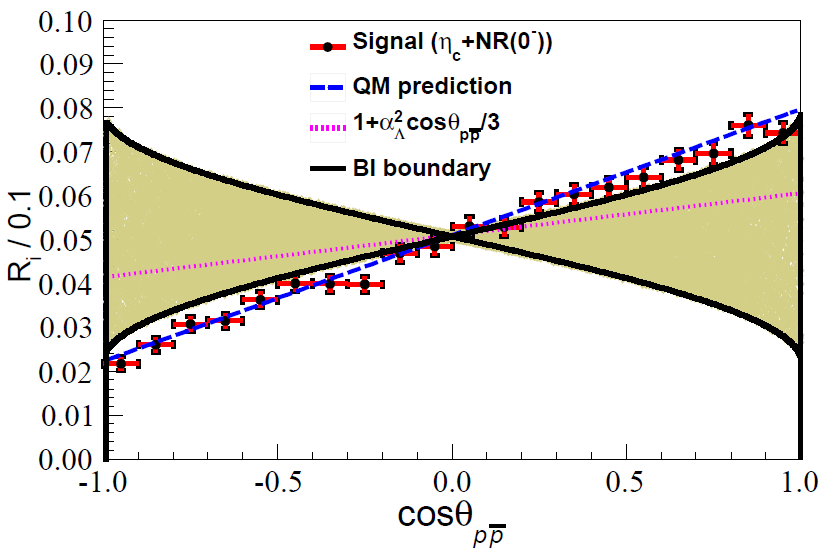

The BESIII Collaboration has achieved a landmark violation of Bell inequalities using entangled hyperon pairs, marking a pivotal test of quantum nonlocality in high-energy physics. Published in Nature Communications (Nat. Commun., 16, 4948 (2025)), the study uses (10.087 ± 0.044) × 10⁹ J/ψ events accumulated at BEPCII/BESIII to probe the ΛΛ entangled system produced in J/ψ→ γηc , and ηc → γΛΛ decays.
Quantum entanglement, famously termed "spooky action at a distance" by Einstein, challenges classical notions of locality. While optical experiments have long tested Bell inequalities, Use of massive entangled hyperons—which decay via both strong and weak interactions—provides a novel platform for such investigations. The ΛΛ system’s self-analyzing spin properties, enabled by parity violation in Λ → pπ⁻, allowed for direct measurement of spin correlations without relying on external detectors.
As illustrated in Figure 2, violation of Local Hidden Variable Theories (LHVT) was observed with 5.2 standard deviation (σ) by analyzing angular correlations between proton-antiproton pairs (Λ → pπ⁻,Λ̄ → p̄π), which revealed a significant violation of the Clauser-Horne (CH) inequality, rejecting LHVT predictions. The experiment also closed the locality loophole by ensuring space-like separation of ΛΛ decays, with an average flight distance of ~6.95 cm, addressing a critical limitation in previous tests. Additionally, the results are consistent with Quantum Mechanics (QM) predictions but contradict the world average from indirect measurements by more than 5.2σ, highlighting discrepancies in prior methodologies.
The Bell and Clauser–Horne–Shimony–Holt inequalities in two QM dependent schemes are tested in this work. The significance to exclude the Bell inequality in ppbar angular distribution region is determined to be 8.9σ (as shown in fig.2). The Clauser–Horne–Shimony–Holt inequality is checked by calculating the Cij tensor using a TOY MC method based on amplitude analysis which excludes the LHVT with a significance exceeding 10σ (as shown in fig. 3).

Fig. 1. The distribution of CH(θppbar )/(αΛ2 )=[(3 cos θppbar-cos(3θppbar ))/4-1/2]. The points with total error bars are the measurements, the solid line is the QM prediction, and thedashed line is the upper bound of the LHVT prediction. The shaded area above thedashed line indicates the violation of the CH(θppbar)inequality.

Fig.2. The angular distribution of cosθppbar, The points with total error bars are the signal, while the dashed line is the QM prediction, with a slope of αΛ. The dotted line represents the QM prediction with Λ polarization determined by a hidden process. The filled region indicates the domain that satisfies the Bell inequality (denoted by BI in this figure).

Fig.3. The distribution of Qmax, and Qmax>1 implies the violation of local realism. The dots with error bars represent the TOY MC results, while the line represents the fitted results using a Gaussian distribution.
This work confirmed quantum entanglement and Bell inequality violation under strong and weak interactions for the first time in high energy physics. It shows that entanglement from these basic interactions has the nonlocal quantum correlation.
Reference: BESIII Collaboration, Nat Commun 16, 4948(2025)
Journal publication: https://www.nature.com/articles/s41467-025-59498-4
DOI: 10.1038/s41467-025-59498-4